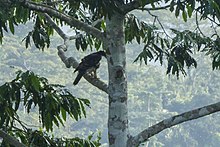Cassin's hawk-eagle
| Cassin's hawk-eagle | |
|---|---|

| |
| Cassin's hawk-eagle in Ghana | |
| Scientific classification | |
| Kingdom: | |
| Phylum: | |
| Class: | |
| Order: | |
| Family: | |
| Genus: | |
| Species: | A. africana
|
| Binomial name | |
| Aquila africana | |
| Synonyms | |
| |
The Cassin's hawk-eagle (Aquila africana) is an eagle, one of the booted eagles, like all eagles it is classified in the family Accipitridae. It occurs in western, central and (very locally) eastern Africa.
Description
The adult Cassin's hawk-eagle has dark brown upperparts, with white spots and a brown tail with three black bars and a broad black subterminal band. The tarsi are white with black streaks, and the underparts are white with black blotches along the sides of the lower breast. It has yellowish brown eyes, the cere and feet are pale yellowish and the bill is black. Juvenile birds are brown on the head with dark brown wings which have white-tipped secondary feathers. The underparts are white, with rufous on the breast while the belly and flanks are marked with dense black spotting. The tail is dark gray with a white tip and dark barring. In flight the juvenile shows pale underwing coverts whereas and adult has dark underwing coverts and a black band along the rear edge of the wing.[4] It measures 50 cm (20 in) in length and has a wingspan of 120 cm (47 in),[5] and weigh 0.9–1.2 kg (2.0–2.6 lb).[4]
Distribution and habitat
West, central and marginally east Africa; from Sierra Leone east to western Uganda south through the Congo Basin to northern Angola.[5][1]
Cassin's hawk-eagle is restricted to primary rainforest.[5]
Habits
The details of the ecology and behaviour of Cassin's hawk-eagle are little known as it is a secretive and rarely seen species, usually seen when soaring over the forest canopy.[5] The nest is constructed with sticks and situated in the canopy of a tree and is lined with fresh foliage. The clutch size is 1-2 eggs which are laid from October-December in Ghana and Gabon, and in December in Uganda. When the stomach contents of collected specimens have been examined they have been found to contain the remains of birds and tree squirrels.[4]
Conservation status
Cassin's hawk-eagle is currently categorised as Least Concern by BirdLife International. Despite a decreasing population, estimated at 1,000-10,000 individuals, Cassin's hawk-eagles has a large geographic range and its population decline is not severe enough for it to given Vulnerable status.[1]
Taxonomy
Cassin’s hawk-eagle was formerly allocated to the genera Cassinaetus, Hieraaetus, and Spizaetus,It was moved to Hieraeetus whenSpizaetus was restricted to Neotropical hawk eagles.[1] Recent molecular studies have shown that Cassin’s hawk-eagle forms a clade with the larger booted eagles of the genus Aquila. There is still some work been done on booted eagle phylogeny so this may change in the future.[4]
References
- ^ a b c d "Aquila Africana". The IUCN Red List of Threatened Species. International Union for Conservation of Nature and Natural Resources. Retrieved 31 October 2016.
- ^ Helbig AJ, Kocum A, Seibold I & Braun MJ (2005) A multi-gene phylogeny of aquiline eagles (Aves: Accipitriformes) reveals extensive paraphyly at the genus level. Molecular phylogenetics and evolution 35(1):147-164 PDF
- ^ "Cassin's Hawk Eagle Aquila africana (Cassin, 1865)". Avibase. Denis Lepage. Retrieved 31 October 2016.
- ^ a b c d "Cassin's Hawk Eagle - Aquila africana". The Eagle Directory. Retrieved 31 October 2016.
- ^ a b c d Kemp, Alan; Kemp, Meg (1998). SASOL Birds of Prey of Africa and its Islands. New Holland. pp. 102–103. ISBN 1 85974 100 2.

